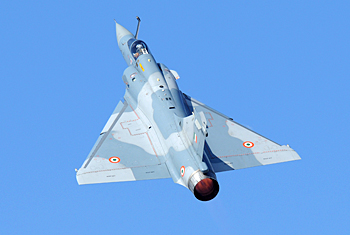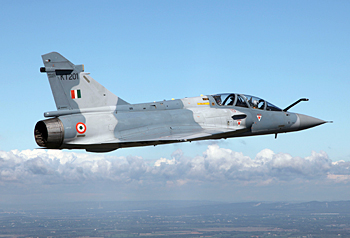INDIAN ARMED FORCES CHIEFS ON OUR RELENTLESS AND FOCUSED PUBLISHING EFFORTS

SP Guide Publications puts forth a well compiled articulation of issues, pursuits and accomplishments of the Indian Army, over the years

"Over the past 60 years, the growth of SP Guide Publications has mirrored the rising stature of Indian Navy. Its well-researched and informative magazines on Defence and Aerospace sector have served to shape an educated opinion of our military personnel, policy makers and the public alike. I wish SP's Publication team continued success, fair winds and following seas in all future endeavour!"

Since, its inception in 1964, SP Guide Publications has consistently demonstrated commitment to high-quality journalism in the aerospace and defence sectors, earning a well-deserved reputation as Asia's largest media house in this domain. I wish SP Guide Publications continued success in its pursuit of excellence.
Upgrade of Mirage 2000 : A Shot in the Arm
Upgrade of the Mirage 2000 fleet will provide the much needed relief to the IAF and a shot in the arm for its combat fleet.
 |
By Air Marshal B.K. Pandey (Retd) Former Air Officer Commanding-in-Chief of Training Command, IAF |


March 25, 2015 was indeed a ‘Red Letter Day’ for the Indian Air Force (IAF) as it was on this day that the first two Mirage 2000 combat aircraft of the IAF upgraded to Mirage 2000-5 Mk 2 standard and re-designated as the Mirage-I for the IAF, were formally handed over to the Indian Ambassador HE Arun K Singh by Eric Trappier, Chairman & CEO of Dassault Aviation at their Flight Test Centre at Istres in France. Pierre Eric Pommellet, Thales Executive Vice President, Defence Mission Systems was also present at this event that flags a major milestone for the combat fleet of the IAF. The remaining fleet of the Mirage 2000 aircraft will be upgraded in India by Hindustan Aeronautics Limited (HAL) under transfer of technology arrangement with Dassault Aviation. The Mirage 2000-I has substantially enhaced operational capability with a new Thales RDY-3 radar, new night vision-compatible all-digital cockpit, the latest avionics, mission computers, glass cockpits, helmet-mounted displays, electronic warfare suites and new weapon systems including the MICA air-to-air missiles from MBDA that is capable of beyond visual range engagement.
While the Mirage 2000 fleet has been in service with the IAF for around three decades and may be regarded as an ageing platform, the upgrade programme will provide the ageing fleet with a new lease of life. Besides, what is more relevant here is that the upgrade programme ought to be viewed in the context of the precarious state the combat fleet of the IAF has descended to over the last decade.
Development of the Combat Fleet
The fleet of combat aircraft is the primary instrument of air power through which the IAF is expected to respond in any aerial conflict with adversaries, to counter any threat to the integrity and sanctity of the national air space or to support operations by surface forces over land or over the sea. It is incumbent on the nation therefore that this vital component of national airpower be built up to and sustained at the level required to meet with the prevailing, emerging or perceived challenges to national security interests. In conformity with this principle, in the post independence era, the combat fleet of the IAF was developed progressively beginning with first generation fighter aircraft in the 1950s. The IAF combat fleet thus went though capability enhancement progressively both through the increase in the number of combat squadrons and induction of second and subsequently third generation combat aircraft to replace those inducted earlier and had been overtaken by obsolescence. As part of the process of periodic renewal, a fleet strength of 50 odd third generation Mirage 2000 multi-role aircraft was inducted into the IAF beginning in the early 1980s.
At the time of induction, the Mirage 2000 fleet was indeed state-of-the-art and it did provide the IAF with a distinct operational edge over the potential adversaries.
Having successfully operated fighter aircraft of French origin such as the Ouragan (renamed Toofani in India) and the Mystere IV, both from the French aerospace major Dassault Aviation, the IAF was very comfortable with their next product on offer, the Mirage 2000. At the time of induction, the Mirage 2000 fleet was indeed state-of-the-art and it did provide the IAF with a distinct operational edge over the potential adversaries. Also, the platform proved highly reliable and with excellent fleet serviceability, the IAF could generate high sortie rates, something that has not been the case with even the fourth generation Su-30 MKI fleet inducted two decades after the Mirage 2000 fleet.
Inductions Lagging Behind
A major component of the periodic fleet renewal plan of the IAF was the Light Combat Aircraft (LCA) Tejas, designed and developed by the Aeronautical Development Agency (ADA) and built by the only Indian aerospace major the HAL. The LCA was meant to replace the huge fleet of MiG-21 family of aircraft that were inducted beginning in the mid 1960s and were being retired from service beginning in the year 2005. The LCA programme having been launched in 1983, the IAF had estimated that the aircraft would be available for induction in the period 2003 to 2008. However, towards the end of the decade of the nineties, it became clear to the IAF that the LCA would not be available in the timeframe estimated initially and there was no guarantee as to when it would be. To cater for the new situation, in 2001, the IAF initiated a proposal for 126 combat aircraft primarily for the air defence role. By 2007, the proposal was eventually metamorphosed into a requirement for Medium Multi-Role Aircraft (MMRCA). Unfortunately, nearly eight years have gone by since the tender for the MMRCA was floated and over three years since the Rafale was declared as the preferred platform, but the contract is yet to be awarded. There are issues to be resolved before the contract negotiations can be finalised.
In the year 2000, the IAF had successfully concluded a contract for procurement from Russia followed by licensed manufacture by HAL of a total of 272 Su-30 MKI, a fourth generation air dominance fighter. Though afflicted with problems, induction of this fleet is progressing and all 272 Su-30 MKI should be with the IAF by 2019. Unfortunately, the Su-30 MKI fleet of around 200 already operational in the IAF has been plagued with deficiencies in product support leading to low serviceability and other technical issues, some suspected to have contributed to accidents involving the aircraft especially in the recent past.
Despite the ongoing induction of the Su-30 MKI fleet, on account of the retirement of vintage fleets such as the MiG-21, MiG-23 and MiG-27 aircraft, the strength of the combat fleet has reduced to 25 squadrons as against the currently authorised level of 39.5. In fact, the government has approved increase in the strength of combat squadrons from 39.5 to 42 by 2022. With the strength of the combat fleet currently reduced to nearly 60 per cent of the enhanced level, there is bound to be serious erosion in the operational potential of the IAF, stout denial by the organisation notwithstanding. The precarious state of the combat fleet of the IAF today needs to be viewed particularly in the context of the growing belligerence on the part of both China and Pakistan and a strong possibility of military collaboration between the two nations that will impinge directly on the national security interests of India.
The problem will be further aggravated if the award of contract for the MMRCA is delayed further as by the end of this decade the remnants of the MiG-21 Bison, upgraded MiG-21 Bis and the MiG-27 fleets are retired from service. As frequently stated by senior functionaries, there is no Plan B in the event of cancellation of the MMRCA tender except to increase the size of the Su-30 fleet. Apart from the fact that this is really no true alternative to the Rafale MMRCA, it will take several years for HAL to deliver the numbers required.
This is where upgrade of the Mirage 2000 fleet will provide albeit only partially, the much needed relief to the IAF and a shot in the arm for the combat fleet!





